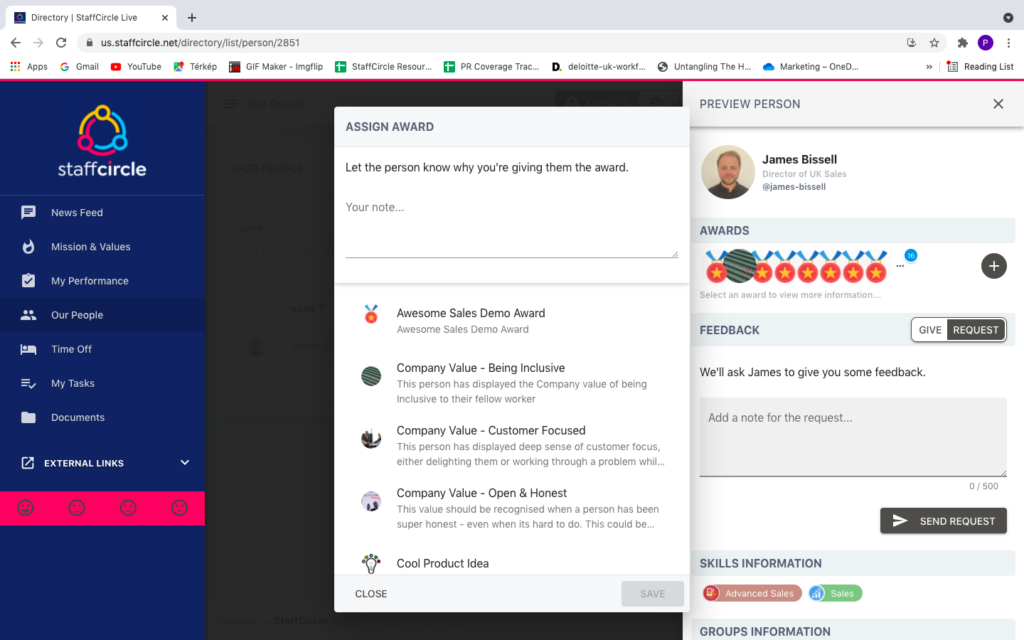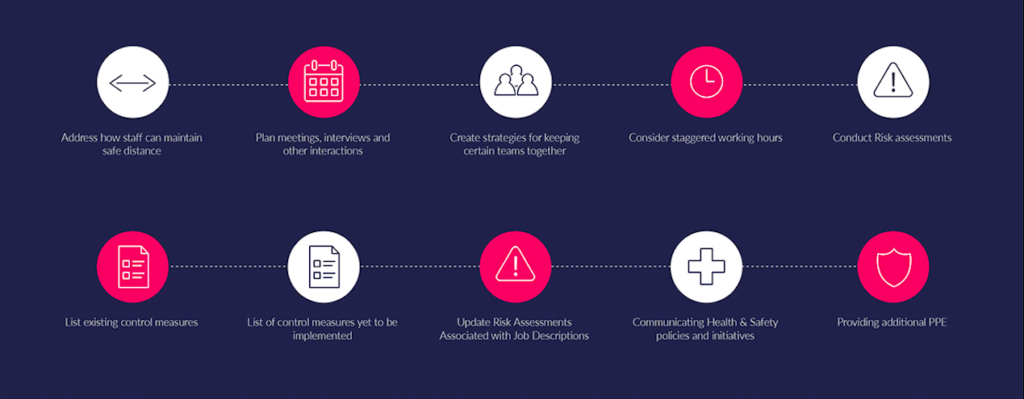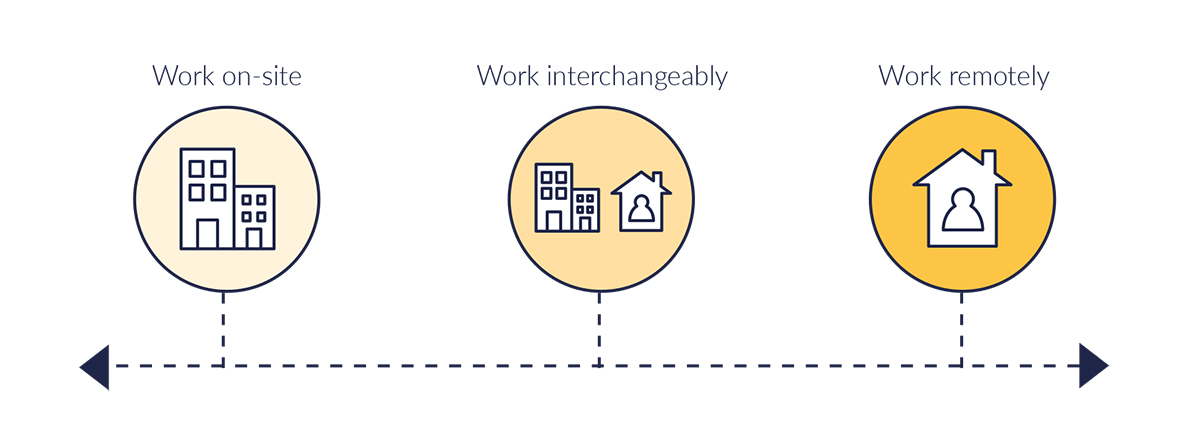Transitioning back to the workplace after Covid-19 is currently the central focus for most organisations. We all want to make the transition as smooth as possible. But the way we work is evolving and thinking that we’ll all return to the office and that working remotely will only happen for the minority of the workforce (or in atypical circumstances) is a legacy mindset focusing only on efficiency and not adaptability.
The pandemic has certainly changed work and employee expectations. This has been highlighted by a recent survey by US-based company, Envoy which found that 47% of people surveyed say they’d look for a new job if their employer didn’t offer hybrid work. Whilst research in the UK indicated that 49% of people are in favour of the continuation of flexible working (an even higher percentage)
HR’s role in transitioning back to the workplace
So HR’s part in reimagining the workforce and the workplace accordingly becomes crucial to success. This begs the question of whether the role of HR should be evolving too. Covid-19 has earned many HR departments the right to a place at the executive table, but it shouldn’t stop there.
As Deloitte put it in their latest Human Capital Trends report “HR needs to reorient its mission and mindset towards shaping future success by taking the lead in re-architecting work“. But how should the role of HR change? We argue that it should become bolder and a more visible force of creating change. Read our full outline here.
Transitioning to ‘what’? A long term focus.
To make transitioning back to the workplace smooth, we need to consider what will we transition back to. Since nearly half of the population expect an increase in home working most businesses realise that remote work is here to stay. But the question goes far beyond the binary issue of whether employees are remote vs. on-site. We need to look at it from the perspective of flexibility and resilience. If the pandemic has taught us anything, it is the need for scalability. (Just think about how many organizations had to redeploy workers to areas of the business where they were needed the most, with no time for re-writing job descriptions and detailed skills mapping.)
A hybrid workforce model offers exactly this kind of flexibility and real-time adaptability. The difference between just offering ‘flexible’ or ‘remote’ work and adopting a hybrid approach is that the latter is truly dynamic in nature. Where and by whom work gets done is driven by achieving the highest levels of productivity and engagement (when and how your workforce performs their best) as opposed to just efficiency.
Making the transition back to the workplace smooth and overcoming challenges
As discussed earlier, except for the minority, returning to the workplace essentially means adopting new ways of working. So this either equals hybrid or flexible workforce models. The Achilles heel of hybrid or flexible work is visibility. Reduced face-to-face communication can impact inclusion and create an ‘out of office’ ‘out of mind’ mentality which often leads to lower employee engagement. Lack of engagement might cause employees to become uninspired and unmotivated.
From an employer’s perspective, a reduction in communication can also mean that workers are not being managed properly which can cause a vicious cycle. Last but not least, communication can impact the success of any mandatory Health and Safety initiatives. So for this reason, we will focus on the links between these key areas.
Driving inclusion and equality
No single policy or program is likely to fit all circumstances and combinations of remote and onsite work. The BBC suggests that when it’s safe, one solution to preventing a divide between those in the office and those at home and stopping an ‘in-group & out-group’ dynamic from developing, (not to mention inadvertently magnifying the gender gap with women often responsible for childcare) could be for all employees to be in the offices on specific days.
If specific ‘all in the office’ days are not possible, having an internal communications strategy and the channels to support inclusion can make all the difference to keeping discussions flowing, employees
in the loop, encouraging new ideas and discussions. Meanwhile, a variety of tools such as desktops/laptops and mobile devices will help with making information and communication accessible for the entire workforce. Providing everyone in the company the same access to these tools means absolute inclusivity regardless of location or time.

Performance management tools that focus on recognition can foster a culture where employees are visibly appreciated for their efforts, work and achievements. Keeping track of these achievements digitally, in a central place can also help with ensuring that moments of success feedback into overall performance evaluations. Whether it’s manager-to-peer or peer-to-peer feedback such positive reinforcement fosters a success orientated culture which is shown to skyrocket engagement.

Health & Safety for transitioning back to the workplace
When transitioning back to work companies will need to think about the capacity limits of each space, taking into consideration social distancing guidelines. This will initially determine how the office layout will change. The CIPD recommends considering the following three key questions before bringing back people into the office.
Is it essential?
In some cases, the return is going to be essential, and the employer needs to communicate this and give clear guidelines. Especially whilst health concerns and risks remain significant, working from home should be supported.
Is it sufficiently safe?
As part of their duty of care obligations, whenever possible, employers should identify and mitigate risks to ensure that work premises are safe to return to. This would include workplace planning to accommodate social distancing, cleaning provisions and changes to working hours.
Is it mutually agreed?
A recent poll found that two in five people are anxious about returning to work. Employers cannot force their employees to return to work if it is unsafe. Understanding your employees and having open channels of communication with them is the only way we can identify concerns and take individual needs and worries into account.
The suggested steps below show potential Health & Safety considerations for transitioning back to the workplace:

Communication
This leads us to communication. Digital communication platforms can help overcome challenges with inclusion and ensure that remote employees have an opportunity to feedback their thoughts and have a voice. Newsfeeds, team chats, social channels, video meetings, phone calls, e-mails and employee pulse surveys are all likely to help with creating a smooth transition back to work.
Using an integrated company newsfeed as part of your communications platform allows remote workers to cut past the often-laborious task of checking their emails and getting to the priorities of the day. While emails can be easily overlooked a newsfeed that highlights urgent issues and offers real-time updates which remote workers can receive across different channels helps to boost the culture of openness and inclusion. Having the tools to communicate health and safety updates results in transparency around important matters like the risk of transmission and the safety measures implemented.
Here’s where you can think beyond the ‘traditional’ communication approaches
Utilising your performance management software or performance management initiatives so that this core messaging is built into the daily lives of your remote workers is the first step towards firmly embedding your culture into their mindset.
Regular One2One meetings and check-ins should be a central component of performance management practices, especially when dealing with hybrid working and remote workers who aren’t always able to engage in the earlier mentioned informal conversations with co-workers and team leaders.
By allowing employees to receive recognition on a daily basis via a performance management app that can be accessed on mobile devices, managers needn’t worry about being unable to communicate this much-needed positive reinforcement.
The bottom line
The future of work is hybrid. Of course, there are always exemptions, but in the light of changing employee expectations for the majority of businesses, it is the new reality. As such, when it comes to drawing up plans for returning to the office if you are thinking long term, you need to consider your approach to hybrid work.
But, hybrid work brings its own challenges especially when it comes to visibility. Lack of visibility can impact on how included employees feel and even on the success of health and safety initiatives. So, the solution to overcome these challenges centres around communications. With a robust approach to communications, a high level of transparency can be created which will preempt issues with visibility.







